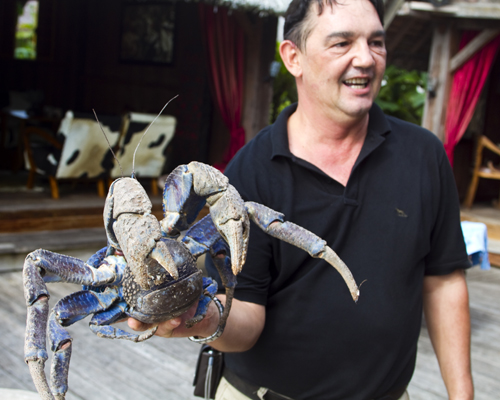This afternoon, just as we were sitting down to lunch, Frederick, the Paris-born general manager at Ratua, came walking in holding the largest coconut crab I’ve ever seen. This particular crab, called krab kokonas in Vanuatu, had a lovely violet coloring to it; the ones I’ve seen in Niue, where they are called ugas, were more bronze and pumpkin colored.
These guys are really one of the most fascinating creatures in the animal kingdom. First of all, even though they are crabs and are born in the ocean, they can’t swim. They are born with the ability to breathe under water but they lose it by the time they’re a month old and will drown if they don’t get to shore. So the little critters head for shore when only a few weeks old. Once they make land, they look for an abandoned snail shell to call home. If they can’t find one that’s a good fit, they’ll use a broken coconut shell instead.
But that’s not why they’re called coconut crabs. They get this moniker because that’s their favorite food (although they have a terrific sense of smell and will scavenge on everything from rotting bananas to dead rats; in fact, one theory on the disappearance of Amelia Earhart has it that coconut crabs consumed her remains and hoarded her bones in their crab burrows). And while they’re happy to feast on coconuts on the ground, they’ve also been observed cutting the nuts off with their pincers and letting them hit the ground and then, if the nut hasn’t opened, carrying it back up the tree and dropping it again—over and over until it cracks. Behavior that is unique in the animal kingdom.
Coconut crabs can live to be 30 years old and weigh up to nine pounds. This guy Frederick is holding is probably at least 15 years old. The thing is, it takes a coconut crab five to eight years to mature (in other words, start having babies). Which, when combined with the fact that they’re pretty damn tasty—or so I’ve been told—explains why they’re endangered. When I had lunch at La Tentation in Port Vila the other day, I noticed that their special was coconut crab soup. Which made me very sad. While it’s not illegal to take coconut crabs in Vanuatu, they do have strict conservation laws (one of which only allows harvesting coconut crabs that are at least 15 years old so they’ve had a chance to reproduce). But imagine making a soup out of some grand creature who, as an egg floating around in the pelagic zone of the ocean for a month, survived every little fish and bird and turtle that came along to eat them, then managed to crawl to dry land and again avoid a thousand predators as he oh-so-slowly grew to be an adult, and now—after 15 or so years of hanging tough—some guy comes along and throws him in a soup.
Sad.
Which is why I was happy when Frederick, after letting me take a few shots of the Ratua coconut crab, released him unharmed back into the jungle. To live another day.
-
They are beautiful…Anthony Bourdain showed some once on an island he was on, ate it though. Said the coconuts they eat makes the meat tender and taste like coconut. Im glad to see you wernt in some sort of frenzy to eat one if they are protected. I applaud a man with some convictions. Im not a peta lobbyist, but it is refreshing to think more people are taking a step back and thinking about what they do. Love the coloring, very beautiful.
Smiles
-
You know, I’d love to try one, but come one–these guys are endangered. So I’m going to eat a 15 year old crab just out of curiosity? Anthony Bourdain should have his hand slapped!
-
Bourdain I believe probably has at a time or two had his hand slapped a few times. But at the same time may not care otherwise.
Smiles
Comments are now closed.


3 comments